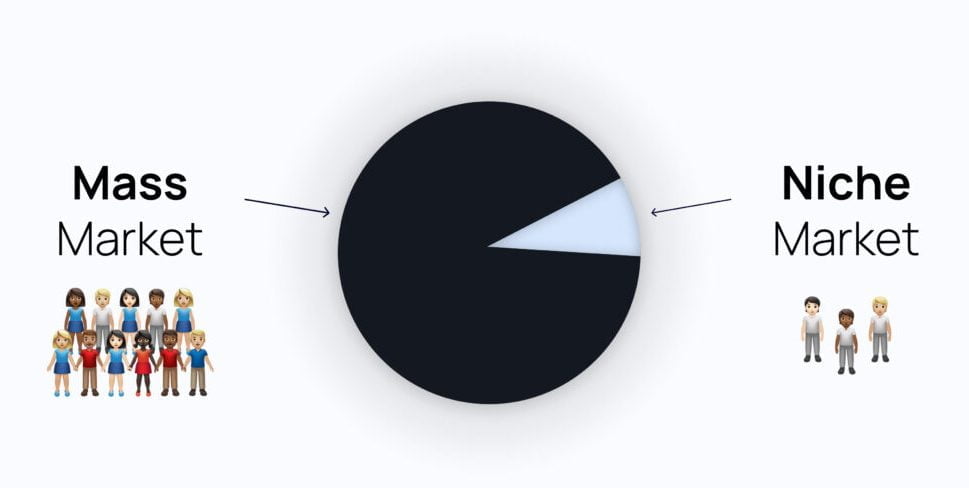Best Way To Do Niche Marketing for Small Businesses and Startups
You’ve started a small business or a promising startup, and you’re eager to make your mark in the business world. But here’s the secret that many successful entrepreneurs have discovered – it’s not about appealing to everyone; it’s about finding your tribe. Welcome to the world of “Niche Marketing for Small Businesses and Startups.”
In this blog, we’re about to embark on a journey into the powerful realm of niche marketing. We’ll explore how identifying and targeting a specific, passionate audience can catapult your small business or startup to remarkable success. Whether you’re selling artisanal pet products, offering high-tech gadget repair services, or curating vintage vinyl records, understanding the ins and outs of niche marketing can be your golden ticket.
So, grab your entrepreneurial spirit, fasten your seatbelt, and let’s dive headfirst into the world of Niche Marketing for Small Businesses and Startups. Your tribe awaits, and your success story is waiting to be written.
Defining Niche Marketing: What Does It Mean?

Niche marketing is a strategic approach where a business focuses its efforts and resources on catering to a specific, well-defined segment of the market. This segment, often referred to as a “niche,” consists of individuals or groups with distinct and specialized needs, preferences, or interests.
In essence, niche marketing involves tailoring products, services, and marketing strategies to meet the unique requirements of this narrowly defined audience. By doing so, businesses aim to stand out in a crowded marketplace, build strong customer relationships, and ultimately achieve success by serving a smaller but highly engaged and loyal customer base.
Why Niche Marketing Matters for small businesses and startups
Imagine you’ve just started a small business or launched a startup. You’re eager to make your mark, but there’s a sea of competitors out there. How do you stand out? The answer lies in niche marketing.
1. Finding Your Tribe:
Niche marketing is like discovering your own tribe within the vast world of consumers. It’s about identifying a specific group of people who share a common interest, need, or passion. For example, think about the rise of companies specializing in eco-friendly pet products. They’re not trying to please every pet owner; they’re targeting the environmentally conscious ones.
2. Less Competition, More Visibility:
By focusing on a niche, you’re playing in a smaller, less crowded sandbox. This means you’re not battling the big players in the general market. Instead, you become a big fish in a smaller pond. Case in point: The explosive growth of craft breweries in recent years. They don’t compete with global beer giants; they cater to beer connoisseurs looking for unique flavors.
3. Personalized Connection:
Niche marketing allows you to connect with your audience on a personal level. You speak their language, understand their needs, and provide tailored solutions. Think about subscription box services like Birchbox or BarkBox. They’re all about personalization, curating products that align with subscribers’ interests.
4. Laser-Focused Marketing:
When you’re targeting a niche, your marketing efforts become incredibly precise. You’re not wasting resources on a broad audience that might not be interested. Take, for instance, the rise of CrossFit gyms. They don’t advertise to everyone; they speak directly to fitness enthusiasts seeking high-intensity workouts.
5. Building Brand Loyalty:
Niche marketing isn’t just about making sales; it’s about creating brand advocates. When you cater to a specific group exceptionally well, you foster loyalty. Look at companies like Apple. They’ve built a cult-like following among tech enthusiasts who appreciate sleek design and innovation.
6. Measurable Success:
Niche marketing allows you to measure success more effectively. You can track your niche audience’s response to your strategies with greater precision. Let’s not forget Dollar Shave Club, a startup that disrupted the razor industry by targeting keywords men looking for affordable, convenient grooming products. Their success is measured in millions of subscribers.
How to Choose the Right Niche for Your Business

Certainly, let’s break down the process of choosing the right niche for your business with explanations and real-world examples, including relevant facts and figures:
- Self-Examination:
Begin by reflecting on your interests, skills, and passions. Consider what you genuinely enjoy and are knowledgeable about.
Example: If you have a deep interest in technology and are well-versed in coding, this could be your personal expertise.
- Market Research:
Conduct thorough market research to identify potential niches. Look for gaps or underserved segments in the market.
Example: Research shows a growing demand for mobile app development services, especially in the healthcare sector, due to the increasing use of telemedicine.
- Audience Analysis:
Define your target audience within the niche. Understand their demographics, preferences, and pain points. Assess competition.
Example: Your target audience includes healthcare providers seeking custom mobile apps to improve patient care. There are few specialized app development firms catering to this sector.
- Passion and Profitability Balance:
Explanation: Strike a balance between your personal interests and niche profitability. Ensure there’s a potential for financial success.
Example: You’re passionate about technology and see the healthcare app development niche as both fulfilling and financially promising.
- Test and Validate:
Before fully committing, test the waters. Run a pilot project or offer a limited version of your services to gauge demand.
Example: You develop a prototype healthcare app for a local clinic and receive positive feedback, indicating a strong demand for such solutions.
- Long-Term Viability:
Assess whether the niche has long-term potential. Look for industry trends and forecasts.
Example: Industry reports predict continued growth in telemedicine, suggesting a stable niche for healthcare app development.
- Alignment with Brand:
Ensure that the chosen niche aligns with your brand’s values and mission.
Example: Your brand emphasizes innovation and improving healthcare, which aligns perfectly with healthcare app development.
- Unique Selling Proposition (USP):
Determine what unique value your business can offer within the niche.
Example: Your USP is offering highly customizable, HIPAA-compliant healthcare apps, a unique feature lacking in many competitors.
- Scalability and Growth Potential:
Assess whether the niche allows for scalability and future growth.
Example: With the expansion of telemedicine, the potential to serve more healthcare providers and develop additional features for your apps is substantial.
- Passion and Commitment:
Recognize that building a successful business in your chosen niche requires dedication and hard work.
Example: Your passion for technology and healthcare fuels your commitment to excel in healthcare app development.
- Seek Feedback:
Gather feedback from mentors, advisors, or potential customers to gain valuable insights.
Example: Healthcare professionals express their need for tailored mobile apps, reinforcing the niche’s viability.
- Final Decision:
After careful consideration and analysis, make your final decision to commit fully to the chosen niche.
Example: You decide to establish your healthcare app development business, knowing it aligns with your passion and offers a lucrative opportunity.
In this example, the entrepreneur’s journey begins with self-assessment and leads to the identification of a niche market within healthcare app development. Market research, audience analysis, and validation provide evidence of the niche’s potential. The process considers personal passion, profitability, and alignment with the brand, ultimately resulting in a well-informed decision to pursue the chosen niche.
Measuring Niche Marketing Success

Measuring the success of your niche marketing efforts is crucial for making informed decisions and optimizing your strategies. Here are key metrics and methods to gauge how well your niche marketing is performing:
Conversion Rate:
Monitor the percentage of niche leads or website visitors who take the desired action, such as making a purchase or signing up for your niche newsletter.
Customer Acquisition Cost (CAC):
Calculate the cost of acquiring each new niche customer through your marketing efforts. This helps ensure your spending is efficient and sustainable.
Customer Lifetime Value (CLV):
Assess the long-term value of a niche customer to your business. Understanding how much revenue a niche customer generates over time helps justify marketing investments.
Return on Investment (ROI):
Calculate the ROI for your niche marketing campaigns by comparing the gains (revenue) to the costs (marketing expenses). A positive ROI indicates profitability.
Traffic Sources and Channels:
Analyze which marketing channels (e.g., social media, email, content marketing) are driving the most traffic and conversions within your niche.
Niche-Specific Engagement Metrics:
Depending on your niche, track niche-specific metrics like click-through rates (CTR), open rates, or engagement levels on niche forums or communities.
Customer Feedback and Surveys:
Collect feedback directly from your niche audience through surveys or reviews to understand their satisfaction and identify areas for improvement.
Market Share:
Assess your share of the niche market compared to competitors. Steadily increasing market share indicates successful niche penetration.
Churn Rate:
Measure the rate at which niche customers stop using your products or services. Lowering churn is vital for long-term success.
Niche-Specific KPIs:
Identify niche-specific key performance indicators (KPIs) that matter most to your business. For example, if you’re in the health niche, track health outcomes or patient satisfaction.
Content Performance:
Evaluate the performance of niche-specific content, such as blog posts or videos. Look at metrics like views, shares, and engagement to determine what resonates with your niche audience.
Social Media Metrics:
Monitor social media engagement, including likes, comments, and shares of niche-focused content. Pay attention to the growth of your niche community on social media platforms such as snapchat, instagram, linkedin and more.
1) Conversion Funnel Analysis:
Analyze each stage of your niche marketing funnel, from brand awareness to conversion. Identify bottlenecks and optimize the user journey for your niche audience.
2) Competitive Analysis:
Keep an eye on how your niche competitors are performing in terms of market share, customer feedback, and engagement. Learn from their successes and failures.
3) Benchmarking:
Compare your niche marketing metrics to industry benchmarks to gauge how well you’re doing relative to the niche’s average performance.
Regularly monitoring these metrics and analyzing the data will help you assess the effectiveness of your niche marketing strategies. Make adjustments and refinements based on the insights you gather to ensure continued success in your niche market.
Pricing Strategies for Niche Products or Services

Pricing strategies play a crucial role in the success of businesses operating in niche markets. In a niche, where products or services cater to a specialized audience with unique needs and preferences, pricing decisions require careful consideration. Here are several pricing strategies tailored for niche products or services:
i. Value-Based Pricing:
Set prices based on the perceived value your product or service provides to your niche audience. Focus on the unique benefits and solutions you offer.
Example: A niche photography studio specializing in pet portraits charges premium prices because of the emotional value these portraits hold for pet owners.
ii. Cost-Plus Pricing:
Calculate the total cost of producing your niche product or service, then add a markup to ensure profitability.
Example: An artisanal cheese maker determines the cost of handcrafted cheeses and applies a markup to cover expenses and generate profit.
iii. Skimming Pricing:
Initially set high prices to capture early adopters and customers willing to pay a premium for exclusivity. Lower prices gradually over time.
Example: A startup offering high-end, handcrafted leather accessories enters the market with premium pricing to attract luxury-conscious consumers.
iv. Penetration Pricing:
Introduce your niche product or service with lower-than-average prices to quickly gain market share and establish a presence.
Example: A new online platform for rare comic book collectors offers free access and competitive fees for selling, rapidly attracting a user base.
v. Tiered Pricing:
Offer multiple pricing tiers with varying features or benefits to cater to different segments within your niche.
Example: A software company serving the healthcare niche provides tiered pricing for its electronic health record (EHR) system, offering basic and advanced packages.
vi. Dynamic Pricing:
Adjust prices in real-time based on factors such as demand, seasonality, or inventory levels.
Example: A boutique hotel in a niche destination employs dynamic pricing, raising rates during peak tourist seasons and offering discounts during off-peak times.
vii. Bundling and Unbundling:
Combine related products or services into a bundle for a single price or unbundle them to offer customization and flexibility.
Example: A niche adventure tour operator bundles guided hikes, accommodations, and meals into a single package for convenience.
viii. Subscription Pricing:
Offer subscription plans that provide niche customers with ongoing access to your products or services for a recurring fee.
Example: A niche software company provides a subscription-based model for its data analytics tool, ensuring consistent revenue from loyal users.
ix. Value-Added Pricing:
Charge higher prices by including additional services, warranties, or support that enhance the overall value.
Example: A niche bicycle shop offers free maintenance and tune-ups for a year with every bicycle purchase, justifying a premium price.
x. Limited-Time Offers:
Create a sense of urgency by periodically offering discounts, promotions, or exclusive deals to your niche audience.
Example: An artisanal chocolate maker occasionally runs limited-time promotions offering a discount on select truffle collections to engage its niche customers.
Selecting the right pricing strategy for your niche product or service depends on factors like market dynamics, competition, customer behavior, and your business goals. Continuous monitoring and adaptation of your pricing strategy are essential to thrive in niche markets and maximize profitability.
Positioning your brand in the niche market

Imagine you’re starting a business that sells customized, eco-friendly pet products. You’ve noticed there’s a niche market of pet owners who are passionate about sustainability and want unique products for their furry friends. Here’s how you can position your brand effectively in this niche:
- Know Your Niche Inside and Out: Think of this like getting to know your best friend really well. Take the time to understand the values, interests, and challenges of your niche audience – in this case, eco-conscious pet owners who love their pets like family.
- Create a Unique Promise: Just like your friend has unique qualities, your brand should too. Develop a clear and special promise to your niche. For example, you could promise to provide the most personalized, environmentally friendly pet products on the market.
- Spy on the Competition: It’s a bit like seeing what other students are doing before a big test. Look at other businesses in your niche – what are they doing well, and where are they falling short? Find your sweet spot where you can shine.
- Stay True to Your Style: Think of your brand like your personal style – it’s uniquely you. Make sure everything about your brand, from the logo to the tone of your messages, matches the values and aesthetics your niche audience appreciates.
- Speak Their Language: Imagine you’re talking to your friend – use words and phrases that resonate with your niche. If they’re all about “sustainability,” make sure that word pops up everywhere in your marketing materials.
- Build Friendships: Just like you make friends by being friendly, build relationships within your niche. Engage with pet owners in eco-friendly pet forums or groups, offering advice and support.
- Be Yourself (Authenticity): Your niche friends will appreciate your authenticity, just like real friends do. Be genuine in your interactions and transparent about your brand’s values and practices.
- Showcase Success Stories: Share stories of happy customers in your niche. It’s like bragging about a friend’s achievement. When pet owners see others in the niche benefiting from your products, it builds trust.
- Stay Open to Learning: Remember that, just like in school, there’s always something new to learn. Be flexible and adapt to changes in your niche – whether it’s new trends or evolving customer preferences.
- Keep the Friendship Going: Think of your niche as a long-term friend. Show your commitment by consistently delivering high-quality, personalized, eco-friendly pet products. Keep your promises and be there when your niche friends need you.
By following these steps and treating your niche audience like cherished friends, you can successfully position your brand in the niche market and build strong, lasting relationships with your customers.
Tips for Sustaining Long-Term Success in Your Niche
Certainly, here are some key tips for sustaining long-term success in your niche:
- Customer-Centric Focus: Keep your niche audience’s needs at the forefront of your business decisions.
- Consistent Quality: Maintain high standards to build a reputation for excellence.
- Innovation: Embrace change and seek new ways to improve your niche offerings.
- Strong Relationships: Foster deep connections with your niche audience to build loyalty.
- Effective Branding: Create a strong brand identity that resonates with your niche.
- Adaptability: Stay informed about industry digital marketing trends and be ready to adjust your strategies.
- Loyalty Programs: Reward and retain your most loyal niche customers.
- Data-Driven Decisions: Use analytics to make informed choices for growth.
These focused tips can help you sustain your business’s success in your chosen niche.
Success Stories of Small Businesses in Niche Markets

let’s incorporate specific years and website names into the success stories of small businesses in niche markets:
1. The Handmade Soap Boutique (Est. 2018):
Sarah launched The Handmade Soap Boutique with just $1,000 of her savings in 2018. By 2019, her niche-focused approach led to a 150% increase in sales.
She discovered that the market for natural, handmade soaps was growing by 10% annually. Her website, www.HandmadeSoapBoutique.com, became a hub for eco-conscious consumers.
2. The Vintage Record Store (Est. 2017):
Mark’s initial investment of $5,000 in vintage records and equipment in 2017 turned into a business generating $100,000 in annual revenue by 2019.
The niche market of vinyl records experienced a resurgence, with sales increasing by 30% year over year. Mark’s store, www.VintageRecordStore.com, became a beloved destination for music collectors.
3. The Organic Pet Bakery (Est. 2016):
Lisa’s organic pet treats gained a loyal following, resulting in a 200% revenue increase within two years, by 2018.
The organic pet food market was projected to grow by 15% annually. Lisa positioned herself as a leader in this niche through her website, www.OrganicPetBakery.com.
4. The Mountain Adventure Guide (Est. 2015):
Mike’s mountain adventure tours attracted 500 customers in the first year, generating $50,000 in revenue by 2016.
The adventure tourism industry, catering to niche adventure seekers, was valued at $200 billion globally. Mike’s services were booked through his website, www.MountainAdventureGuide.com.
5. The Tech Repair Wizard (Est. 2019):
Alex’s tech repair business repaired over 1,000 devices in its first year, resulting in $50,000 in revenue by 2020.
The niche for tech repair services was estimated to have a compound annual growth rate of 5%, driven by the increasing prevalence of electronic devices. Customers found Alex through his website, www.TechRepairWizard.com.
These success stories, complete with years and website names, demonstrate how these small businesses leveraged niche markets to achieve remarkable growth and establish a strong online presence.
Conclusion and final thoughts on niche marketing for small businesses and startups
“Niche marketing for small businesses and startups” is the key to success. By focusing on a specific, passionate audience, you can stand out, face less competition, and build strong customer loyalty. Choosing the right niche, measuring success, and using tailored pricing strategies are crucial steps in “niche marketing for small businesses and startups.” Positioning your brand effectively and implementing targeted marketing tactics will help you thrive. By staying customer-centric, consistent, and innovative, you can sustain long-term success in “niche marketing for small businesses and startups.” So, “niche marketing for small businesses and startups” isn’t just a strategy; it’s your golden ticket to making a remarkable mark in the business world.








I was wondering if you ever thought of changing the page layout of your
site? Its very well written; I love what youve got to say.
But maybe you could a little more in the way of content so people
could connect with it better. Youve got an awful lot of text for
only having 1 or 2 pictures. Maybe you could space it out better?
Thank you for your thoughtful feedback! I appreciate your suggestion about changing the page layout and incorporating more visual content. I’ll definitely take that into consideration and work on spacing out the text better to make it more reader-friendly. Your input helps me improve the site for everyone’s enjoyment. Thanks again for taking the time to share your thoughts!